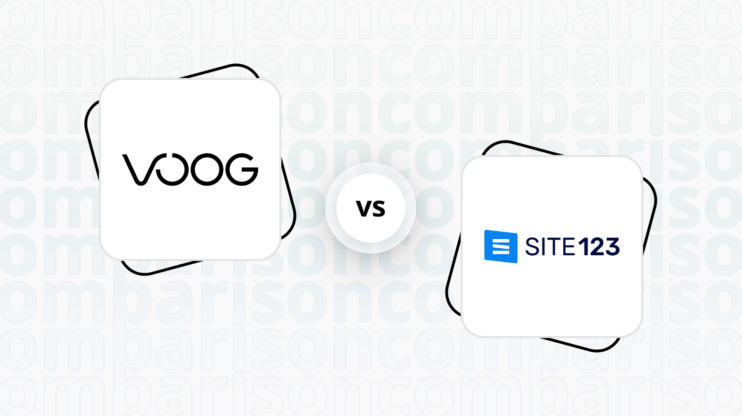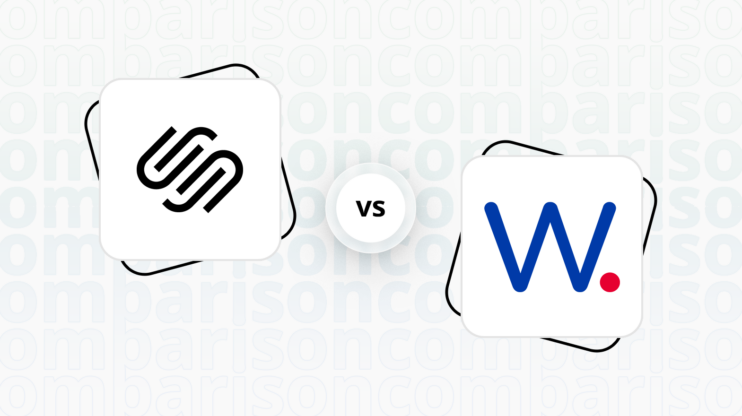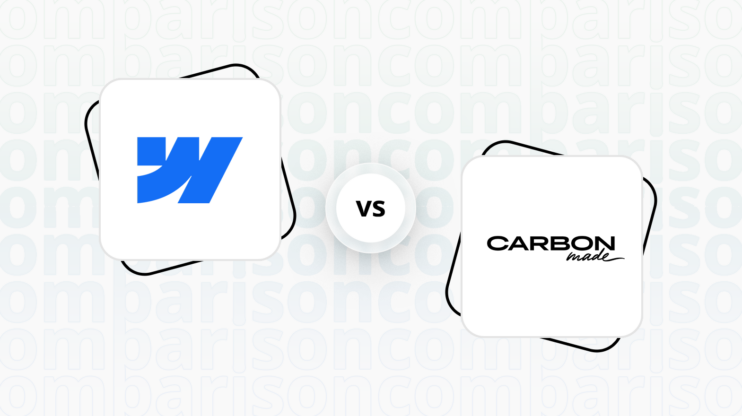Final verdict
Webflow and Blocs both offer unique advantages, but they cater to different user needs and preferences.
-
Webflow (Overall Grade: 7.9/10)
is a comprehensive platform designed for professional designers and developers. It excels in providing powerful design tools, a flexible CMS, and top-tier hosting services. Webflow is ideal for users who need advanced customization and are comfortable with a steeper learning curve. When comparing Webflow vs Blocs, Webflow stands out for its robust ecommerce features, superior website speed optimization, and extensive marketing tools. -
Blocs (Overall Grade: 5.8/10)
is a user-friendly website builder tailored for Mac users. It offers an intuitive visual interface and pre-designed blocks, making it accessible for beginners and those without coding knowledge. Blocs is perfect for users looking for a straightforward, no-code solution to create professional websites quickly. In the Webflow vs Blocs comparison, Blocs shines in ease of use and AI capabilities, but it falls short in areas like hosting quality and advanced ecommerce functionalities.

|

|
|
|---|---|---|
|
Design functionalities & templates |
8.6 |
7.5 |
|
Ease of use |
7.5 |
8.7 |
|
Ecommerce |
8.5 |
7.0 |
|
Website Editors |
9.0 |
7.5 |
|
Product testing options |
6.3 |
7.0 |
|
Price |
8.0 |
9.0 |
|
Hosting quality |
8.9 |
0 |
|
Website speed optimization |
8.1 |
5.2 |
|
Plugins and integrations |
5.5 |
6.8 |
|
Marketing features |
7.8 |
6.9 |
|
Customer support |
8.3 |
5.1 |
|
Security |
7.8 |
0.0 |
|
AI capabilities |
8.3 |
5.4 |
|
User Management |
8.3 |
1.4 |
Best for ecommerce
 8.5
8.5
 7.0
7.0
Verdict
: Blocs is suitable for those who prefer integrating third-party ecommerce solutions, while Webflow offers a more comprehensive built-in ecommerce experience.
-
Webflow
: Known for its powerful design tools and flexible CMS, Webflow is ideal for users who want a robust, all-in-one ecommerce solution. It provides extensive customization options and integrates seamlessly with major payment gateways. When comparing Webflow vs Blocs, Webflow stands out for its built-in ecommerce features and flexibility. -
Blocs
: Designed specifically for Mac users, Blocs offers a user-friendly interface and relies on third-party integrations for ecommerce functionality. It is a good choice for those who prefer using specific ecommerce platforms like Ecwid or Gumroad. However, it may not match Webflow’s depth in ecommerce capabilities.
Best for informational & business websites
 8.6
8.6
 7.5
7.5
Verdict
: When it comes to creating informational and business websites, Webflow stands out as the superior choice due to its powerful design tools, flexible CMS, and top-tier hosting services. Blocs, while user-friendly and ideal for Mac users, doesn’t quite match up to Webflow’s comprehensive capabilities.
-
Webflow
: Webflow is a robust platform designed for professional designers, offering a wide array of design features and a flexible CMS. It allows users to build and launch responsive, cleanly-coded websites without extensive coding knowledge. With a score of 8.6, Webflow excels in providing powerful design tools and top-tier hosting services, making it a comprehensive solution for creating custom, responsive websites. -
Blocs
: Blocs is a user-friendly website builder specifically for Mac users, allowing the creation of modern websites without coding. It offers a range of features including responsive design and pre-made templates. However, with a score of 7.5, Blocs is more suited for users looking for simplicity and ease of use rather than the advanced functionalities that Webflow provides. When comparing Webflow vs Blocs, Blocs is ideal for those who prioritize ease of use and are working within the Mac ecosystem.
Detailed comparison
Design functionalities & templates
Design FunctionalitiesRepresents how well each platform allows for creative design and customization of websites.Score Components:
- Template Variety (30%): Range and quality of design templates.
- Customization (30%): Flexibility and options for design alterations.
- User Interface (20%): Ease and intuitiveness of the design process.
- Responsiveness (10%): Adaptability to different devices and screen sizes.
- Innovation (10%): Unique design features and tools.
 8.6
8.6
 7.5
7.5
Winner: Webflow.
If you’re looking for a platform that offers more creative control, a wider array of design features, and a larger selection of templates, Webflow is the preferred choice.
Webflow delivers a robust design experience with a diverse range of template and customization options. Boasting over 1000 pre-built templates covering various industries and website types, including free and premium options, Webflow ensures a constantly evolving library for users. The design customization features include a visual drag-and-drop editor for real-time adjustments, fine-grained control over every aspect of the design, and the ability to inject custom code for advanced users seeking additional personalization and unique functionalities.
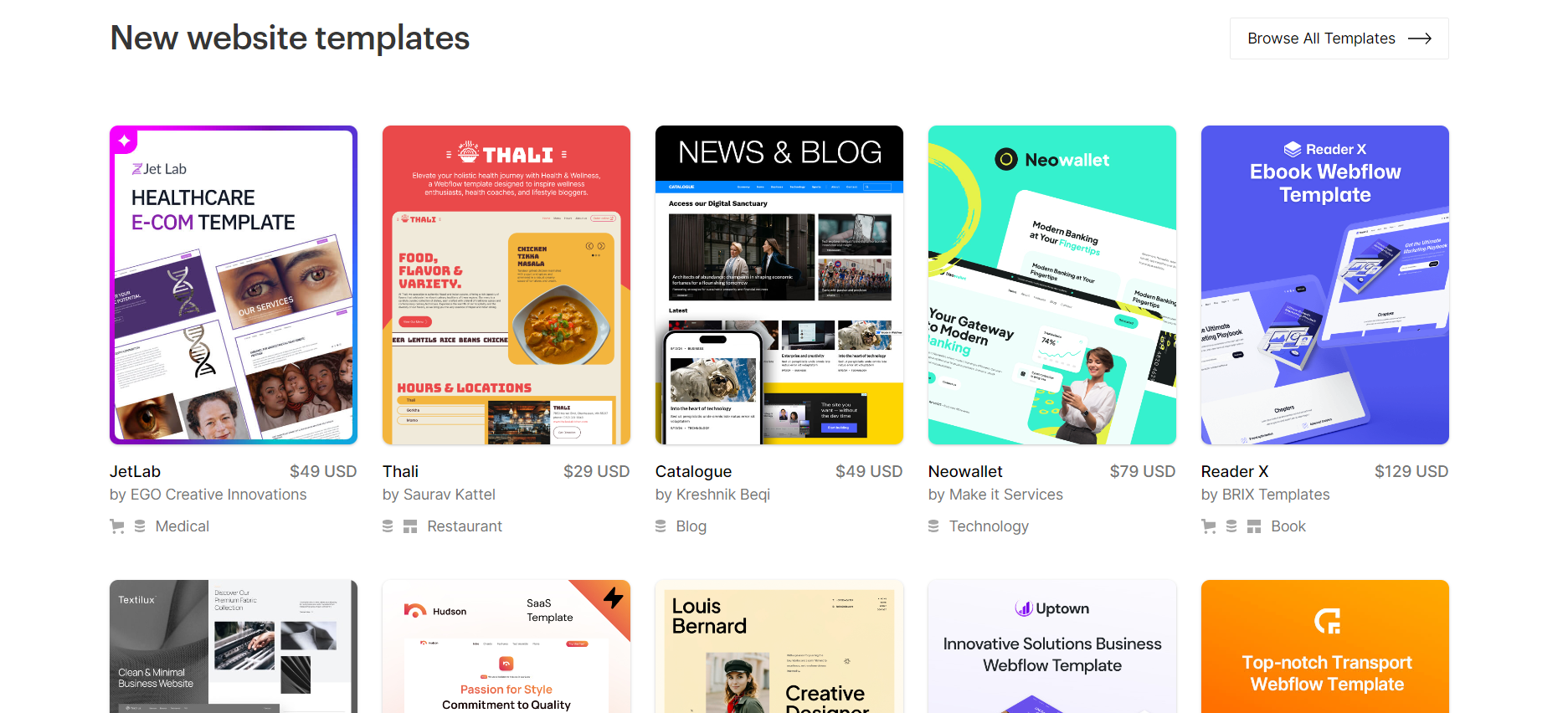
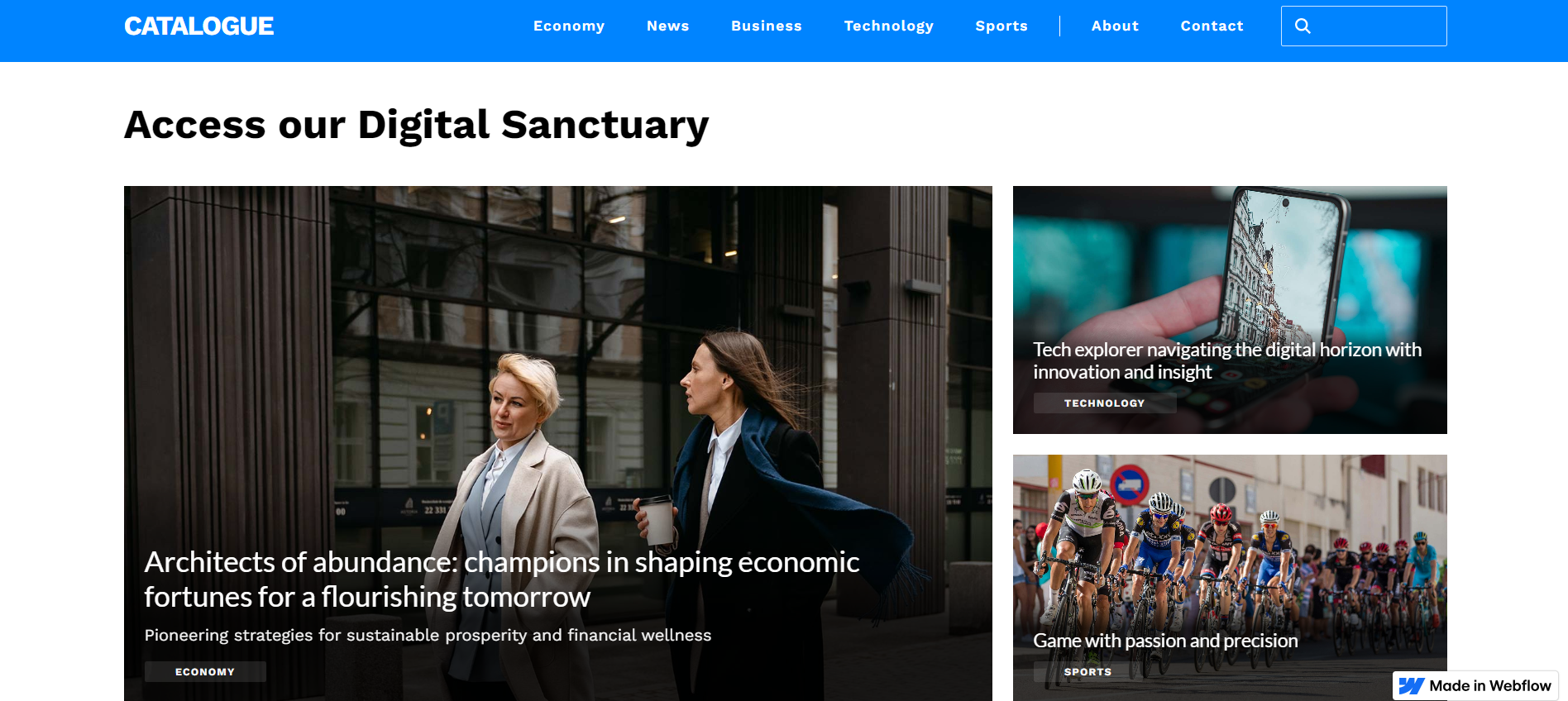
Compared to Webflow, Blocs website builder offers a vast selection of design templates, boasting over 36 layouts for various website types, including business, e-commerce, personal portfolios, and photography, catering to a wide range of user needs. These templates are designed to be responsive, ensuring optimal display across different devices, from desktops to smartphones. Furthermore, the templates are available for purchase in packages, with pricing dependent on the number of websites intended for creation, and are crafted for easy customization, enabling users without coding expertise to quickly develop professional-looking websites.
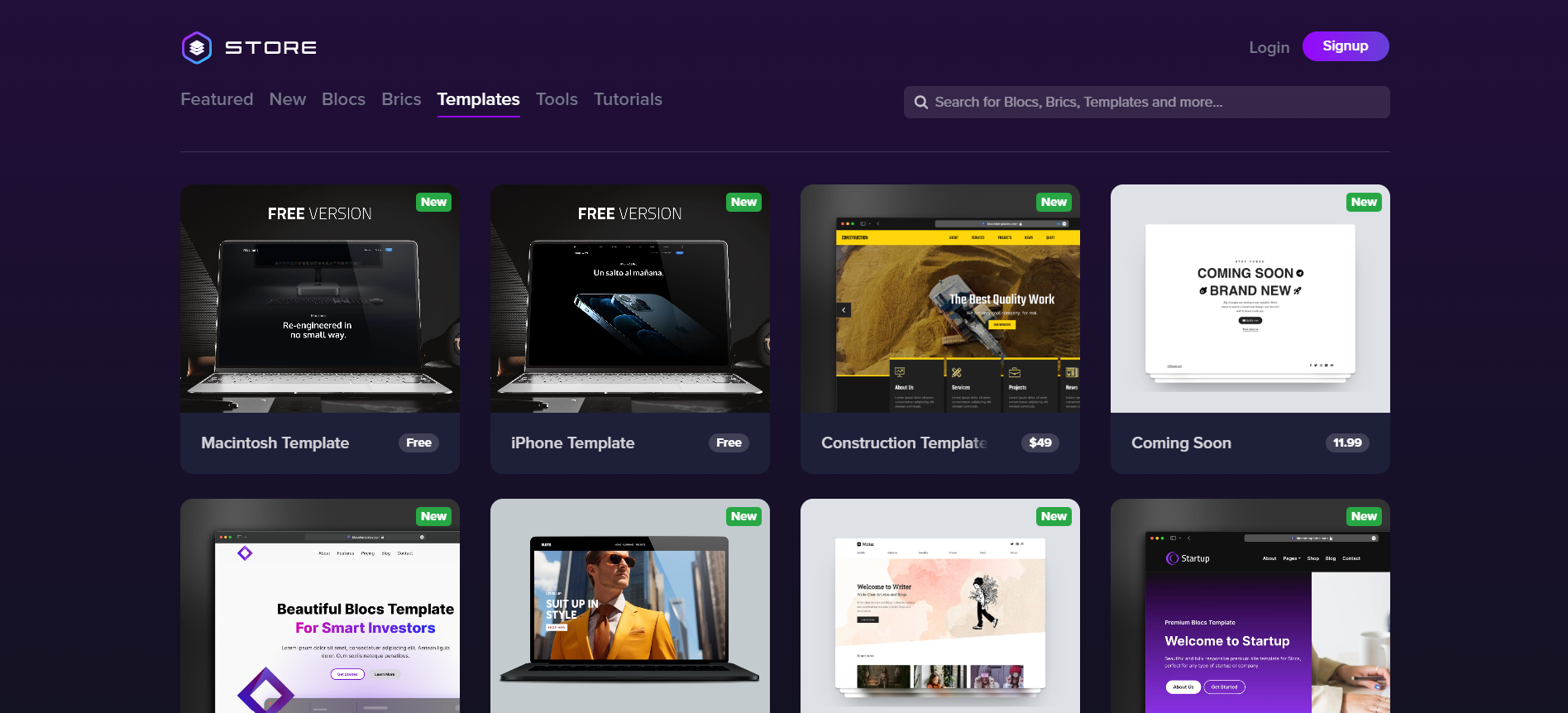
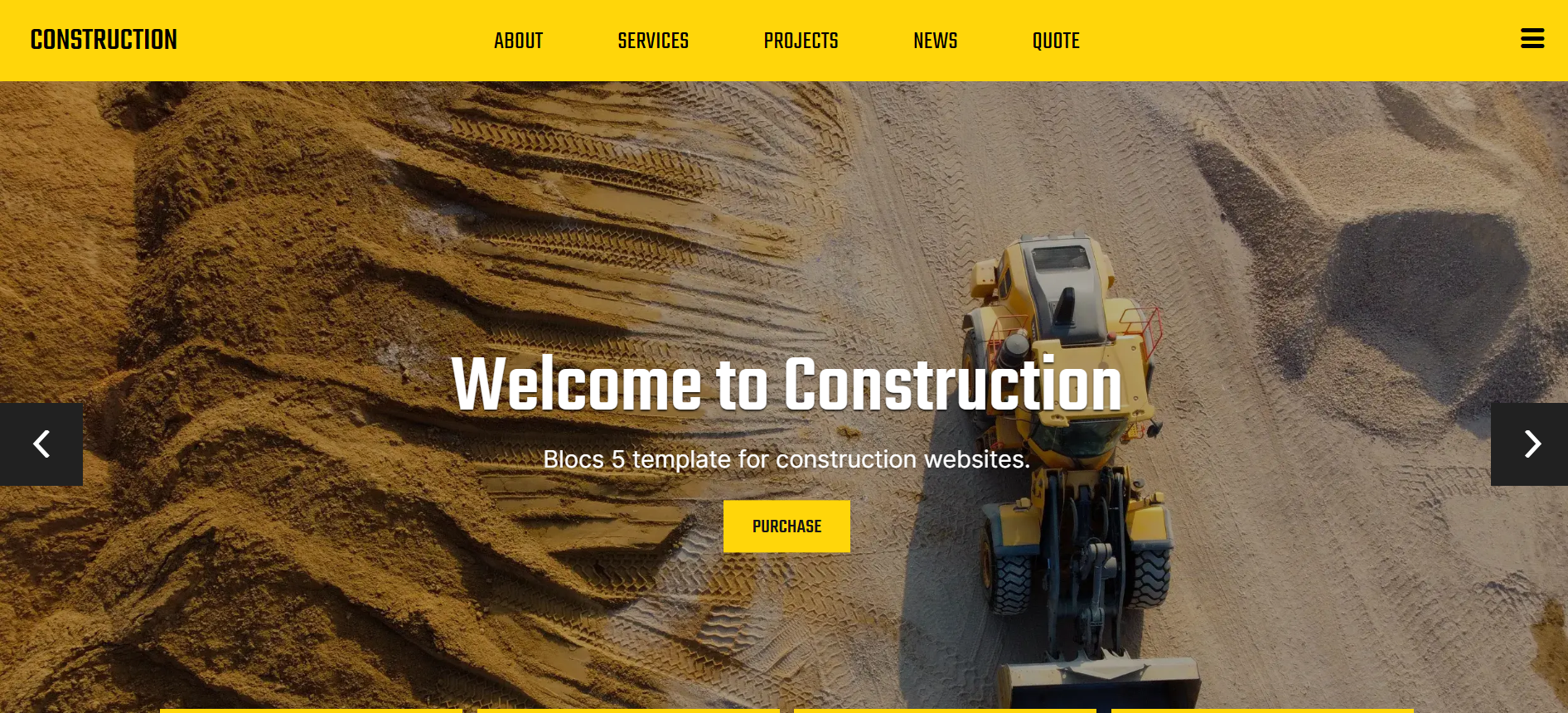
Get a head start on website creation with AI
Create a custom website tailored to your business needs 10X faster with 10Web AI Website Builder!
Ease of use
Ease of useReflects the platform’s overall user-friendliness.Score
Components:
- Learning curve (40%): Quickness and ease of getting started.
- Interface design (30%): Simplicity and intuitiveness of layout.
- User guidance (20%): Quality of tutorials and support.
- Flexibility (10%): Adaptability to various user skills.
 7.5
7.5
 8.7
8.7
🏆 Winner: Blocs
. With a score of 8.7, Blocs is highly regarded for its user-friendliness and versatility, particularly among Mac users. It offers a robust platform for both novices just starting to explore web design and professional coders seeking to create unique layouts. Webflow, scoring 7.5, is user-friendly for experienced designers and developers, but beginners may find it challenging due to a steeper learning curve.
Learning Resources
🏆 Winner: Webflow
. Both platforms offer solid learning resources, but Webflow goes a step further with its comprehensive set of learning resources for individuals seeking proficiency in the platform. Webflow University serves as an excellent starting point, delivering diverse courses and tutorials covering fundamental to advanced aspects of Webflow.
For ecommerce
EcommerceMeasures the platform’s effectiveness in supporting online business activities.Score Components:
- Ecommerce themes and templates (20%): Variety and design of templates.
- Product management (25%): Ease of managing and organizing products.
- Payment options (25%): Variety and convenience of payment methods.
- Ecommerce features (20%): Features for managing an ecommerce store.
- Integration (10%): Compatibility with external e-commerce tools and services.
 8.5
8.5
 7.0
7.0
Webflow and Blocs both offer ecommerce capabilities, but they approach it differently. Webflow provides a comprehensive set of built-in ecommerce features, while Blocs relies on integrations with third-party ecommerce platforms.

|

|
|
|---|---|---|
|
Ecommerce themes and templates |
7.5 |
7.8 |
|
Product page customization |
8.3 |
6.5 |
|
Payment processing and commissions |
7.8 |
7.0 |
|
POS capabilities |
6.5 |
0.0 |
|
Payment gateways |
8.0 |
7.5 |
|
Product numbers |
7.0 |
6.0 |
|
Additional ecommerce features |
7.9 |
7.2 |
Webflow ecommerce features:
- Checkout and Payment Processing with Stripe, PayPal, etc.
- Marketing and Promotions
- Tax and Shipping calculations
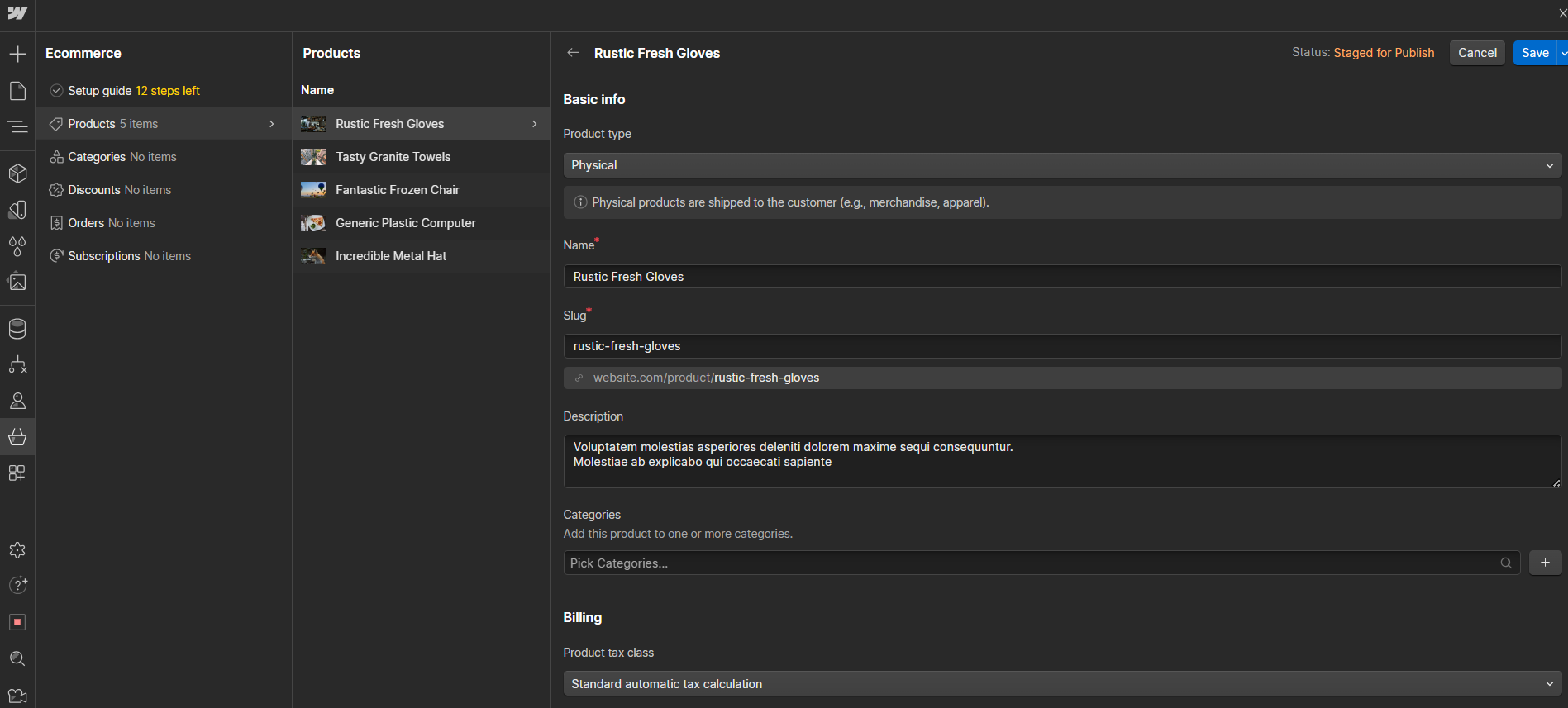
Blocs ecommerce features:
- Stripe integration
- Snipcart shopping cart integration
- Gumroad integration
- Ecwid integration
Webflow offers a diverse range of ecommerce themes and templates designed to cater to various types of online stores. Each template comes equipped with built-in ecommerce functionality, allowing you to easily add products and manage your store without the need for coding. On the other hand, Blocs provides a range of ecommerce-specific templates, allowing users to quickly launch optimized online stores or business platforms. These premium templates are designed to be fast, visually appealing, and SEO-friendly.
Product page customization
When it comes to product page customization, Webflow offers extensive options, allowing users to design and personalize their pages without coding. It provides tutorials for creating product pages from scratch, offers responsive templates for various devices, and allows users to add custom code and dynamic content using Webflow’s CMS for maximum customization flexibility. Blocs, however, primarily offers ecommerce features through third-party ecommerce platforms such as Ecwid, so the product page customization possibilities vary depending on which platform is integrated.
Payment processing
In terms of payment processing, Webflow provides a flexible and secure platform through integrations with leading payment gateways like Stripe and PayPal. This allows users to accept a wide range of payments, including credit card transactions directly from their websites. Blocs supports ecommerce through integrations with third-party ecommerce providers, suggesting flexibility in the use of various payment gateways. However, Blocs does not offer POS capabilities.
Considering the features, availability, cost, and flexibility, Webflow appears to be a more robust and flexible ecommerce solution compared to Blocs. However, if you are looking for a platform that allows for integration with specific third-party ecommerce platforms, Blocs might be a suitable choice.
Website Editors
Website EditorsEvaluates the platforms’ website building and editing capabilities.Score Components:
- Customization tools (40%): Range and power of editing features.
- Editor usability (30%): User experience within the editor.
- Design flexibility (20%): Freedom in layout and design changes.
- Update and maintenance ease (10%): Simplicity of updating and maintaining the site.
 9.0
9.0
 7.5
7.5
🏆
Winner: Webflow
. With a score of 9.0, Webflow’s editor is praised for its intuitive visual interface that simplifies the process of designing and editing responsive websites without requiring deep technical knowledge. It offers a perfect blend of ease of use for beginners and the flexibility for more advanced users, enabling significant cost savings by allowing users to customize and manage their sites without hiring professionals.
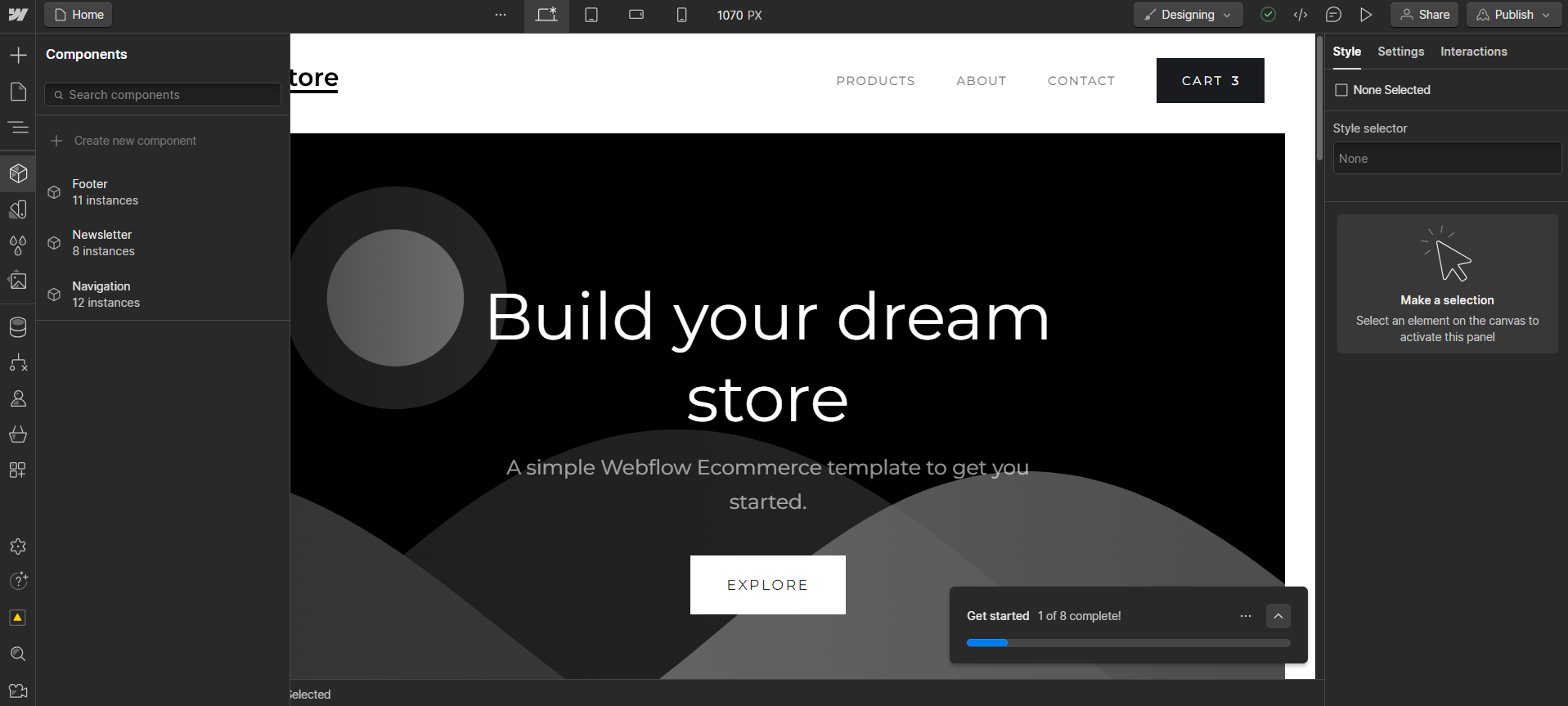
Blocs, scoring 7.5, offers a user-friendly web design tool that enables the creation of modern, responsive websites without needing to code. It utilizes a block-based interface with drag-and-drop functionality, making web design accessible to designers and creatives without technical backgrounds. However, its block-based approach might limit the customization options for more advanced users who prefer granular control over every aspect of their website’s design and functionality.
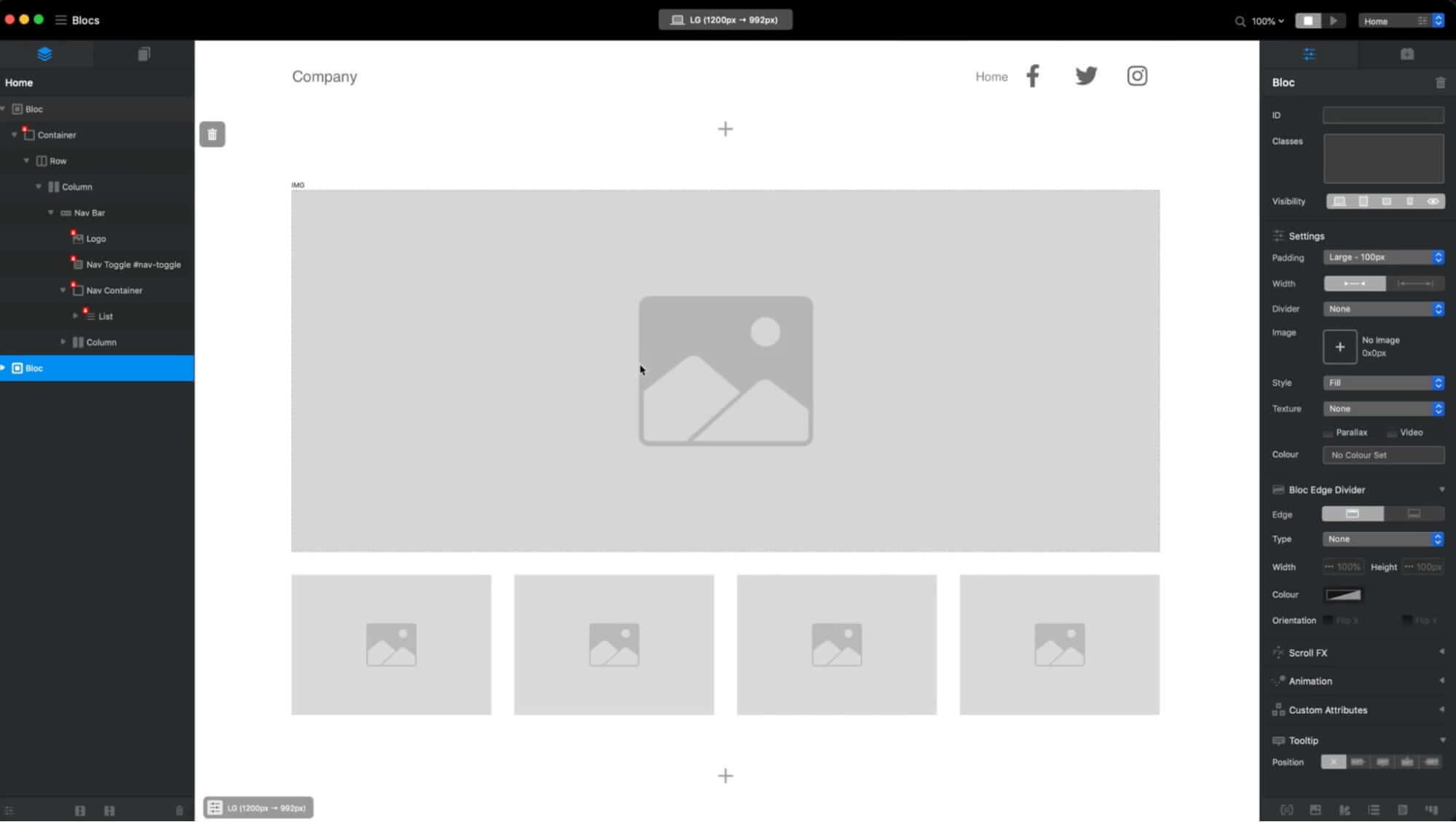
Mobile editor/app
 7.0
7.0
 8.5
8.5
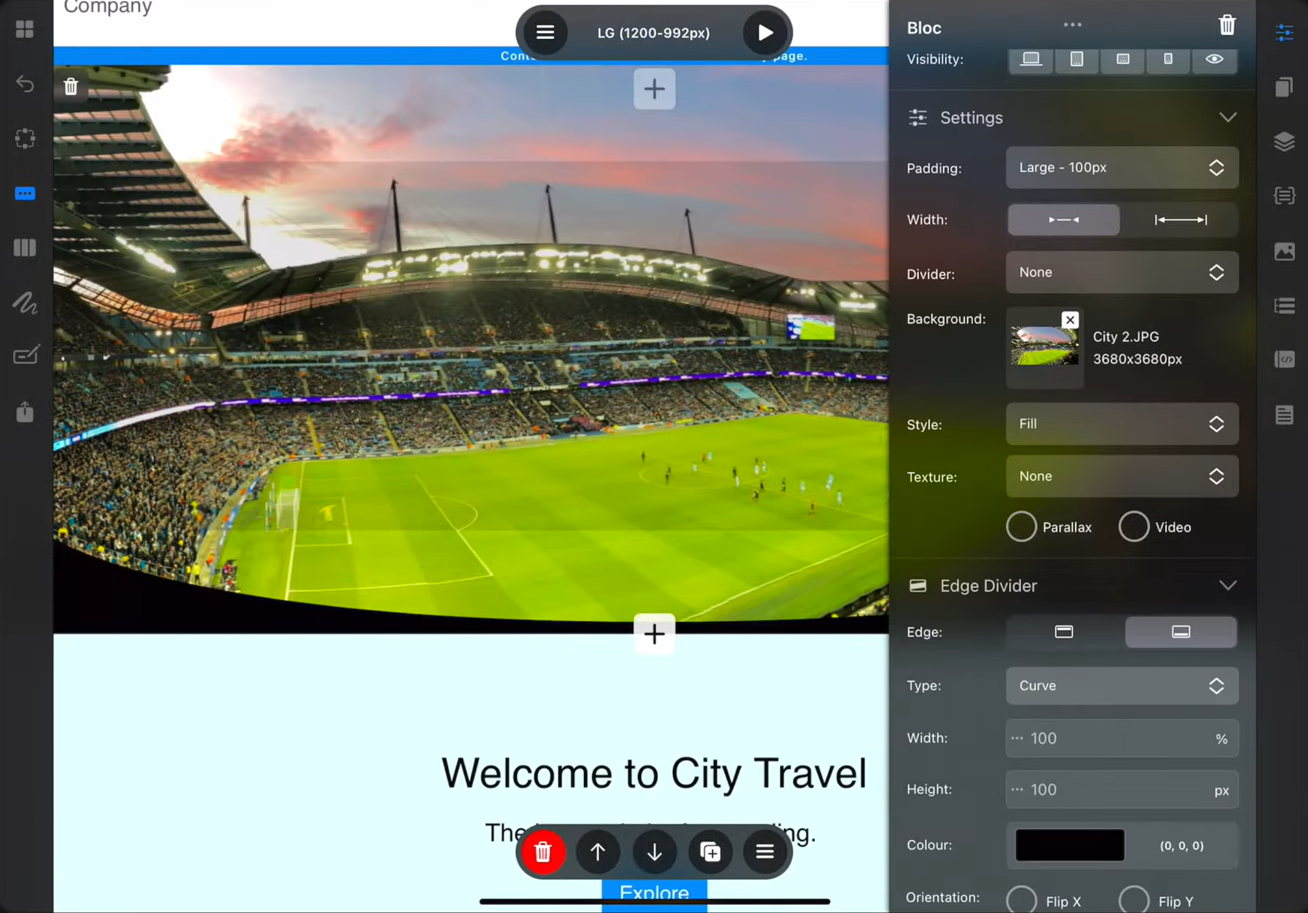
🏆
Winner: Blocs
. Both Webflow and Blocs offer mobile solutions for managing your website, but they cater to different needs and platforms. Webflow does not have an official mobile editor app, but there is a third-party app called EditFlow, created by a community member for Webflow users. Currently, the app is only available for iOS.
Blocs, on the other hand, has a mobile editor app specifically designed for the iPad. This app provides a touch-first interface and includes all the essential features needed to create various types of websites, offering a flexible and efficient solution for building professional and beautiful websites on an iPad.
In summary, Blocs receives a higher rating due to its dedicated mobile editor app, while Webflow relies on a third-party solution.
Product testing options
Product Testing OptionsAssesses the options for trying out platform features before commitment.Score Components:
- Trial quality (40%): Extent and usefulness of the trial or free version.
- Feature accessibility (30%): How many features are available to test.
- Trial duration (20%): Length of the trial period.
- Ease of transition (10%): Smoothness of moving from trial to paid plans.
 6.3
6.3
 7.0
7.0
Overall Result
:
Blocs Wins
. Blocs scores 7.0, slightly higher than Webflow’s 6.3. Blocs offers a trial version and a 14-day money-back guarantee, allowing users to test some of its features. Webflow, on the other hand, offers a free version with basic features but does not provide a trial version or a money-back guarantee.

|

|
|
|---|---|---|
|
Free Plan |
Yes |
No |
|
Trial Duration |
No |
Yes |
|
Testing Premium Features |
Basic features with free plan | Some features with free trial |
|
Money Back Guarantee |
No |
14-day money back guarantee |
Price
PriceLooks at the cost-effectiveness and value for money of each platform.Score Components:
- Plan value (40%): What each pricing tier offers.
- Transparency and clarity (30%): Clearness of pricing structures.
- Flexibility of plans (20%): Range of options to suit different budgets.
- Hidden costs (10%): Additional expenses not included in the plan.
 8.0
8.0
 9.0
9.0
Webflow offers a range of plans, including options for ecommerce, while Blocs has a one-time payment model.

|

|
|
|---|---|---|
|
Free |
Starter (Free): Limited features for new sites, including 2 static pages and 50 form submissions lifetime. |
No offering at this amount. |
|
$10-$20 |
Basic ($18/month): Suitable for simple sites with a custom domain, including basic SEO controls and 500 monthly form submissions. And 100 pages. Value for price: 6.5 |
No offering at this amount. |
|
$20-$30 |
CMS ($29/month): For content-driven sites with 2,000 CMS items, 1,000 monthly form submissions, and full API access. And 150 website pages. Value for price: 7.5 |
No offering at this amount. |
|
$40-$45 |
Standard ($42/month): For new businesses with up to 500 ecommerce items, includes basic ecommerce features, and 2% transaction fee Value for price: 8.5 |
No offering at this amount. |
|
$45-$50 |
Business ($49/month): High traffic capacity, advanced features like site search, and up to 10 content editors. Value for price: 8.0 |
Blocs Plus (+$49.99): An add-on to the Blocs 5 plan, providing additional features such as the ability to build custom WordPress themes without writing code, extract typography, assets, and color schemes from any website, a productivity-boosting image editor, a class styles library manager, and an SEO helper. Value for price: 8.5 |
|
$80-$100 |
Plus ($84/month): Higher volume businesses with 0% transaction fees, up to 5,000 ecommerce items, and advanced features. Value for price: 9.0 |
Blocs 5 ($99.99): This plan offers a native Mac app with no subscription required. It allows building unlimited websites, works offline, includes animations & scroll FX, powerful interactions, no page limit, font manager, writer mode, auto backup, all V5 updates, and email support. A Blocs license can be used on one Mac and all future Blocs V5 updates come for free. Value for price: 8.0 |
|
$200+ |
Advanced ($235/month): Scalable solution for large online stores with up to 15,000 ecommerce items and the highest caps and 0% transaction fees. Value for price: 9.5 |
No offering at this amount. |
location. As a result in rare cases the prices displayed here can differ from the ones you see on their
websites.
Hosting quality
Hosting
qualityExamines the reliability and performance of the hosting solutions.Score Components:
- Uptime (40%): Consistency and reliability of website availability.
- Speed (30%): Loading times and performance.
- Bandwidth and storage (20%): Sufficiency of resources provided.
- Data centers (10%): Quality and distribution of hosting infrastructure.
 8.9
8.9
 0
0
🏆
Winner: Webflow
Webflow offers managed hosting included in all of their plans, with a 99.99% uptime guarantee on their Enterprise plan. They leverage a globally distributed network of data centers from Amazon Web Services (AWS) and Fastly. Blocs, on the other hand, does not offer hosting services, which gives Webflow a clear advantage in this category.

|

|
|
|---|---|---|
|
Do they offer hosting? |
Yes, included in all plans |
Not offered |
|
Data Centers: |
AWS and Fastly |
Not offered |
|
Type of hosting: |
Managed Hosting |
Not offered |
|
Uptime: |
99.99% |
Not offered |
|
Uptime Guarantee: |
Yes, 99.99% (Enterprise) |
Not offered |
Website Speed Optimization
Website Speed OptimizationEvaluates optimization of website loading timesScore Components:
- PageSpeed Score (30%): Google’s score indicating performance optimization.
- Loading Time (30%): The average time until a website is fully interactive.
- Mobile Optimization (15%): Optimization effectiveness for mobile devices.
- Resource Optimization (15%): Optimizing images, scripts, and other heavy resources.
- CDN Usage (10%): Use of CDN to enhance speed across geolocations.
 8.1
8.1
 5.2
5.2
🏆 Winner: Webflow
Both Webflow and Blocs have strategies for website speed optimization, but Webflow’s comprehensive approach and higher Website Speed Optimization score give it the edge.

|

|
|
|---|---|---|
|
Focus |
Custom Cache Settings, Custom Element Lazy Loading, Automatic Minification, Responsive templates, CDN |
WebP Generation |
|
Performance Tools |
Google Lighthouse, PageSpeed Insights |
Google PageSpeed Insights |
|
Key Strategies |
Custom Cache Settings, Custom Element Lazy Loading, Automatic Minification, Responsive templates, CDN |
WebP Generation |
|
Load Times |
Below 2 seconds average |
Varies depending on optimization and website complexity |
|
Page Speed Scores Range |
77.2/100 |
Varies depending on optimization and website complexity |
|
Core Web Vitals Improvement |
Improving components’ usability, and emphasis on LCP, FID and CLS |
Blocs does not disclose any information about its Core Web vitals improvements |
Webflow’s approach to enhancing site speed includes custom cache settings, custom element lazy loading, automatic minification, responsive templates, and a content delivery network (CDN). This comprehensive approach, combined with an average load time of below 2 seconds and a PageSpeed score of 77.2/100, makes Webflow a strong contender in terms of website speed optimization. Webflow also places emphasis on improving the usability of components and Core Web Vitals (LCP, FID, and CLS).
On the other hand, Blocs’ strategy for speed optimization is centered around WebP Generation. However, Blocs does not disclose any specific information about its Core Web Vitals improvements. The load times and PageSpeed scores for Blocs vary depending on optimization and website complexity, which makes it difficult to provide a definitive comparison.
Get a head start on website creation with AI
Create a custom website tailored to your business needs 10X faster with 10Web AI Website Builder!
Plugins and integrations
Plugins and integrationsMeasures the range and effectiveness of additional plugins and integrations.Score Components:
- Variety of options (40%): Range of available add-ons.
- Integration smoothness (30%): Ease of integrating plugins into the site.
- Quality of plugins (20%): Functionality and reliability of the options.
- Custom integration capabilities (10%): Support for custom or third-party integrations.
 5.5
5.5
 6.8
6.8
🏆 Winner: Blocs.
With a score of 6.8, Blocs takes the lead in this category. It offers a variety of custom-made add-ons and extensions that enhance web design capabilities, facilitating a richer web development experience. Webflow, scoring 5.5, doesn’t have plugins or extensions in the traditional sense. Instead, it offers a built-in library of website elements and functionalities that you can use to create your website. This library is constantly being expanded, so you’ll always have access to the latest features and tools. However, Blocs’ emphasis on ease of use and learning, providing extensive resources, tutorials, and community support to ensure users can quickly master their features and extend their web design projects, gives it the edge in this category.
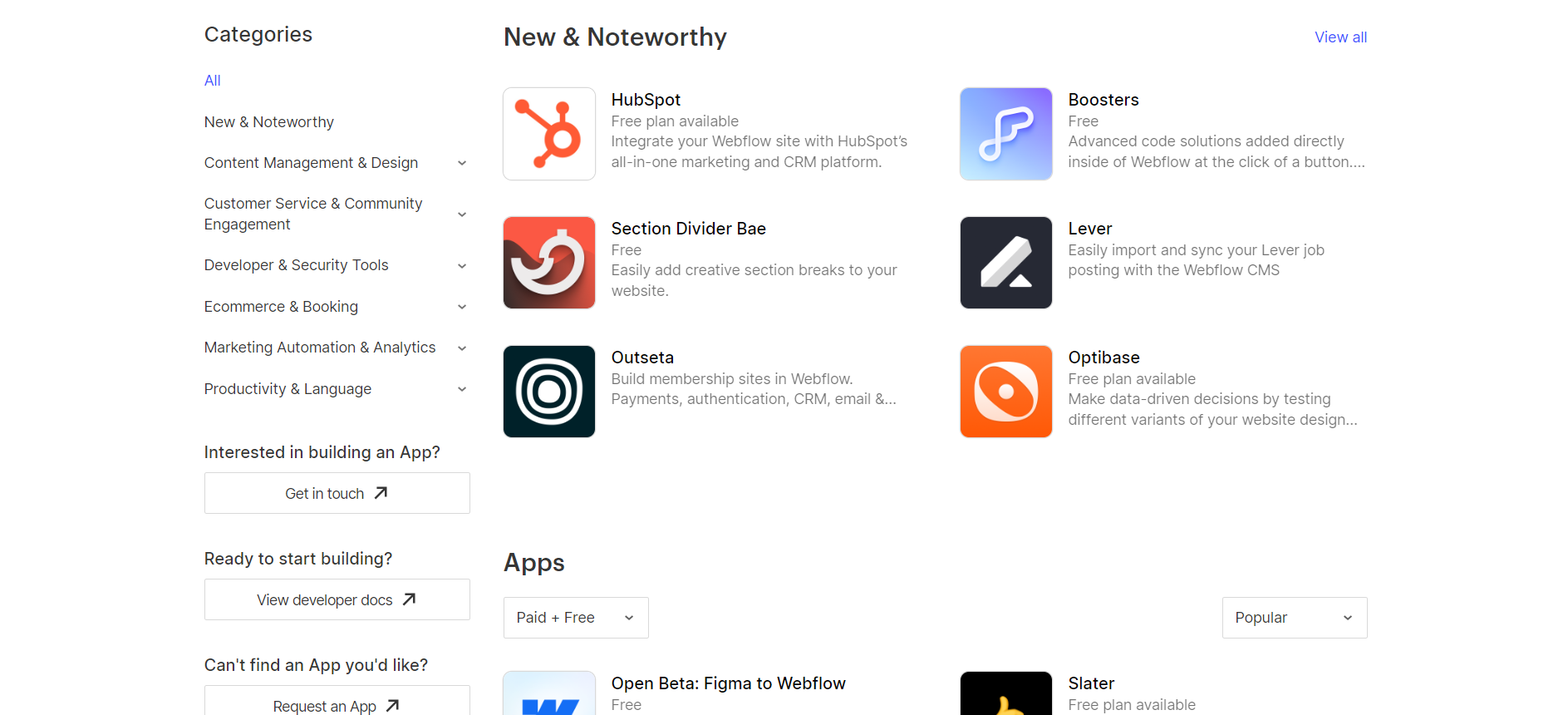
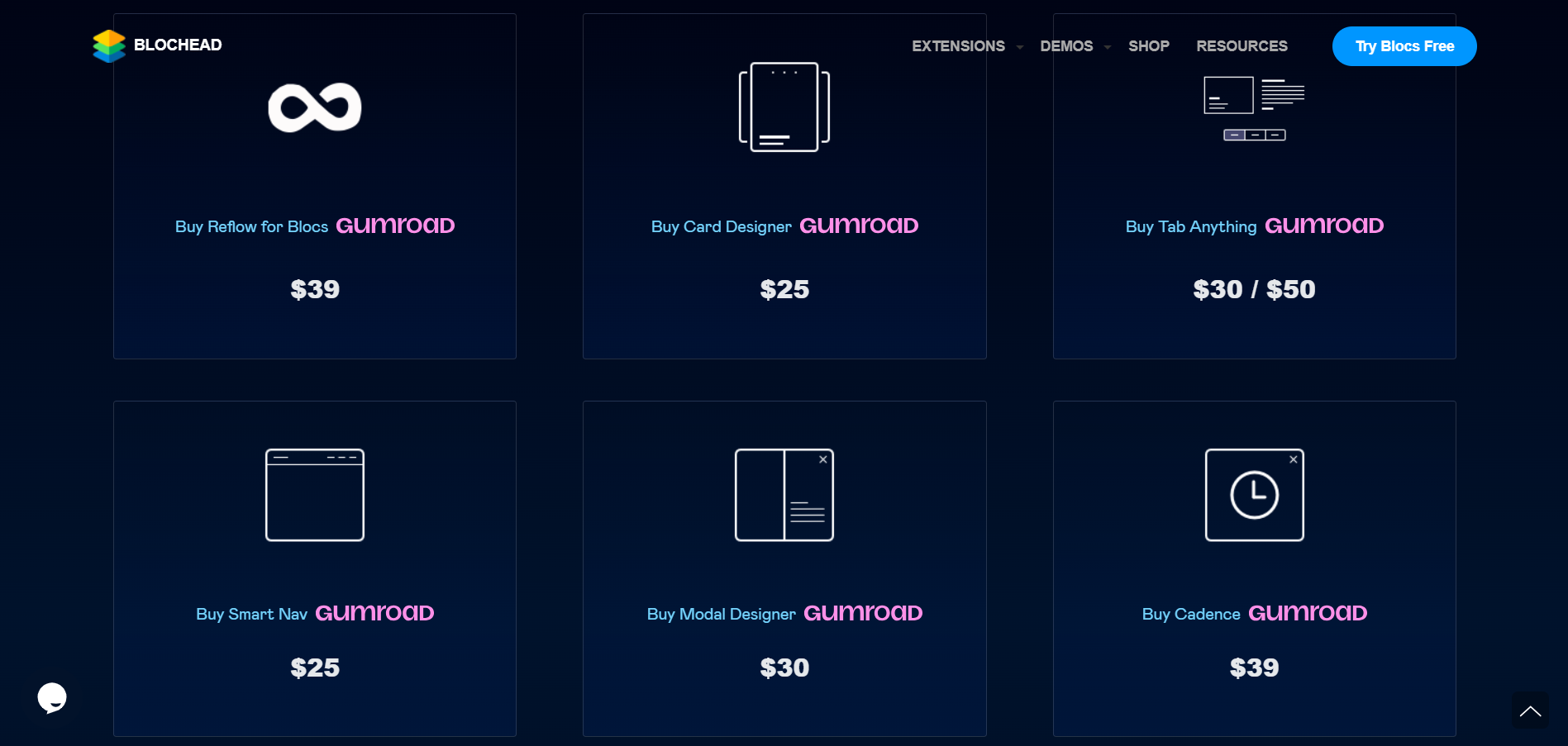
Marketing Features
Design FunctionalitiesRepresents how well each platform allows for creative design and customization of websites.Score Components:
- Template Variety (30%): Range and quality of design templates.
- Customization (30%): Flexibility and options for design alterations.
- User Interface (20%): Ease and intuitiveness of the design process.
- Responsiveness (10%): Adaptability to different devices and screen sizes.
- Innovation (10%): Unique design features and tools.
 7.8
7.8
 6.9
6.9
🏆
Overall Winner: Webflow
. Webflow stands out for its comprehensive marketing tools, especially in SEO, email marketing, and ad campaign management. Blocs, while offering a solid range of features, lacks in the area of ads and promotions.

|

|
|
|---|---|---|
|
SEO Tools |
|
|
|
Email Marketing |
|
|
|
Blogging |
|
|
|
Social Media Integration |
Simplifies content sharing and audience engagement on major social platforms |
Yes |
|
Analytics and Reporting |
Integrates with Google Analytics for comprehensive web traffic and behavior analysis |
Yes, via Google Analytics integrations |
|
Ads and Promotions |
Supports ad and promotion management through integration with platforms like Google Optimize |
No |
Customer Support
Customer supportEvaluates the quality and availability of support options.Score Components:
- Response time (40%): Speed of support responses.
- Support quality (30%): Effectiveness and helpfulness of the support.
- Availability (20%): Range of support channels (phone, chat, email).
- Resource richness (10%): Quality of self-help and educational materials.
 8.3
8.3
 5.1
5.1
🏆 Winner: Webflow
. In the Webflow vs Blocs comparison, Webflow stands out with a higher customer support score of 8.3. Webflow offers 24/7 support through live chat, email, and a community forum, ensuring users can get help whenever they need it. Additionally, Webflow provides extensive documentation and video tutorials, making it easier for users to navigate the platform and resolve issues independently.
Blocs, on the other hand, has a customer support score of 5.1. While it offers support through articles and a community forum, it lacks the direct, personalized support that some users may require, especially when dealing with complex issues. This reliance on self-service resources can leave users feeling unsupported compared to the more comprehensive support system provided by Webflow.
Security
SecurityLooks at the platforms’ security measures and data protection.Score Components:
- Data protection (40%): Safeguards for user and customer data.
- SSL and encryption (30%): Implementation of secure connections.
- Compliance (20%): Adherence to industry security standards.
- Regular updates (10%): Frequency of security updates and patches.
 7.8
7.8
 0.0
0.0
🏆
Winner: Webflow
. Webflow takes a comprehensive approach to security, implementing robust encryption techniques, strict access controls, and regular system updates and audits. This ensures that user data remains confidential and protected. Webflow also uses SSL encryption to secure data transmission and offers two-factor authentication for added security.
On the other hand, Blocs does not provide specific information about its security measures. As Blocs is primarily an offline website builder and does not offer hosting, its security measures largely depend on the hosting provider chosen by the user. Therefore, in terms of security, Webflow is the clear winner.
AI Capabilities
AI capabilitiesMeasures the effectiveness of AI-driven features and tools.Score Components:
- Automation efficiency (40%): Impact of AI on streamlining processes.
- Personalization (30%): AI-driven customization for users or customers.
- AI-Assisted design (20%): Role of AI in website design and functionality.
- Data analysis (10%): Use of AI in interpreting user data and analytics.
 8.3
8.3
 5.4
5.4

|

|
|
|---|---|---|
|
AI Builder |
|
|
|
AI Ecommerce features |
|
|
|
AI content generation |
|
Available with AI Assistant |
|
Additional AI features |
Announced, but not yet available |
Available with AI Assistant |
🏆 Winner: Blocs
. While neither Webflow nor Blocs currently have an AI builder or AI ecommerce features, Blocs takes the lead with its AI Assistant that allows for content generation and editing directly within a Blocs project. This feature, along with the ability to target specific elements within a project, makes Blocs a more versatile and interactive design tool.
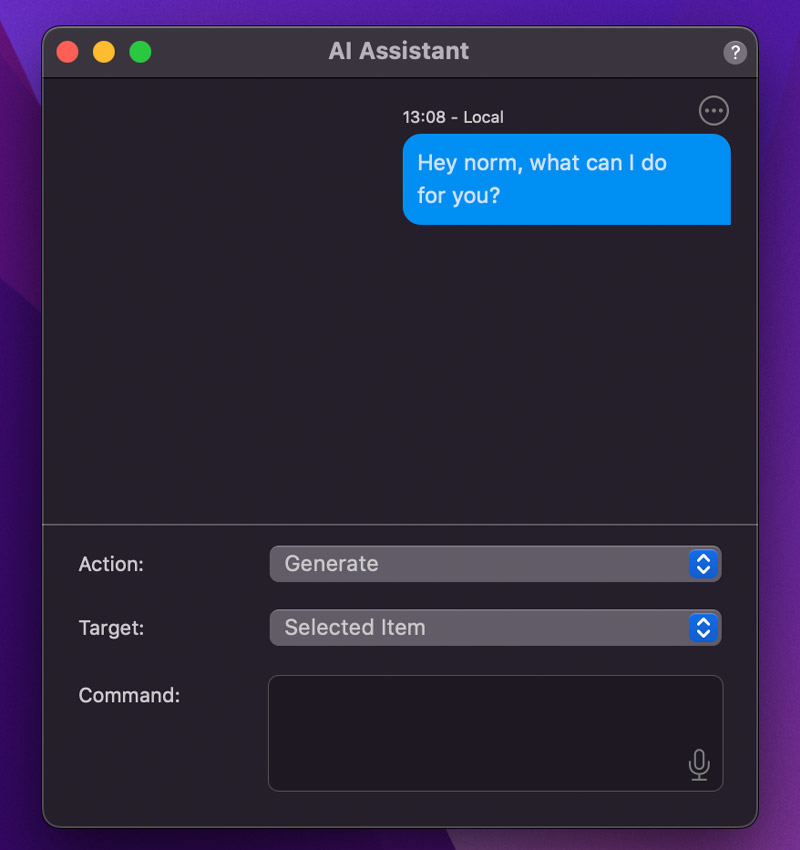
Webflow, with a score of 8.3, does not currently have AI capabilities, but they have announced plans to introduce AI features in the future. These features are aimed at helping users create visually appealing websites more efficiently and automating content updates and personalization based on user behavior and preferences.
Blocs, with a score of 5.4, does not have an AI builder, but it does have an AI Assistant that enhances the user experience by allowing for the generation and editing of content directly within a Blocs project. This feature, along with the ability to target specific elements within a project, makes Blocs a more versatile and interactive design tool.
User Management
User ManagementAssesses the platforms’ capabilities in managing user roles, permissions, and accessibility.Score Components:
- Role Customization (40%): Flexibility in creating and defining user roles and
permissions. - Ease of Management (30%): User interface and tools for managing users.
- Access Control (20%): Effectiveness of access control measures for different user
levels. - Scalability (10%): Ability to manage a growing number of users efficiently.
 8.3
8.3
 1.4
1.4
🏆 Winner: Webflow
. Webflow and Blocs have different approaches to user management.
- Webflow offers a variety of user roles with different access levels, making it suitable for collaborative work. The number of users who can edit a website and their access levels vary by plan. Core, Growth, and Enterprise plans offer unlimited editors, while others limit content editors to 3 or 10 per site. Access levels include Designer for full access and Editor for content editing. Workspace roles like Admin, Designer, and Editor ensure collaboration and security through features like the Site Activity Log and role-based permissions.
- Blocs, on the other hand, only allows one user to build and edit a website, which limits its usability for larger teams or projects that require collaboration.
Webflow User Roles and Access Levels:
| Role | Description | Access Highlights |
|---|---|---|
| Workspace Owner | Full control over Workspace settings and member management. | Edit settings, manage billing, access/edit all sites, invite/remove members, manage permissions. |
| Workspace Admin | Similar to the owner with some restrictions. | Edit settings, manage billing, access/edit all sites, invite/remove members (except owner), manage permissions. |
| Workspace Member | Limited control focused on site interaction. | Download invoices, access/edit sites, invite members. |
| Workspace Guest | Temporary collaborators with limited access. | Access/edit sites. |
| Workspace Commenter | Limited to commenting for feedback on sites. | Create/view/resolve comments, preview sites. |
| Site Admin | Full control at the site level. | Manage permissions, delete/transfer sites, billing management, design and publish changes. |
| Can Design | Design capabilities with some restrictions on publishing. | Design in Designer, create/modify classes and components, publish changes with permission. |
| Can Design (Limited) | Restricted design capabilities for Enterprise customers. | Create new classes, modify created classes, limited publishing capabilities. |
| Can Edit | Content editing without full design privileges. | Edit text/links/images, manage assets, publish Collection items and Ecommerce products. |
| Can Comment (Site Level) | Commenting for feedback at the site level. | Create/view/resolve comments, preview sites. |
Blocs does not provide user roles and access levels as it only allows one user to build and edit a website.
Additional Features

|

|
|
|---|---|---|
|
SSL Certificate |
|
|
|
Custom Domain |
|
|
|
Free Custom Domain Included |
|
|
|
International Domains |
|
|
|
Mobile Responsive |
|
|
|
Page Speed |
|
|
|
Website Builder Mobile App |
|
|
|
Convert a Website To An App |
|
|
|
Website Analytics |
|
|
|
Multilingual Sites |
|
|
|
Multiple Users |
|
|
User Feedback
Webflow receives high praise for its user-friendly interface, eliminating the need for coding while offering extensive design flexibility. Users appreciate its scalability, cost-effectiveness, and seamless integration of essential features like forms and CMS. However, some users note a slight learning curve and occasional limitations, particularly in ecommerce functionalities and content management. Overall, Webflow proves to be a powerful tool for building and managing websites, offering robust features for both beginners and experienced developers, albeit with some room for improvement in certain areas like collaborative editing and content management.
Blocs website builder is praised for its intuitive drag-and-drop interface, making it accessible to users with varying levels of web development expertise. Its extensive library of templates and customization options, including the ability to add custom CSS and JavaScript, facilitates the rapid creation of diverse and visually appealing websites. However, users report encountering bugs and express a desire for more sophisticated customization features, indicating room for improvement. Overall, Blocs is valued for significantly streamlining the web design process, supported by a strong community and educational resources, despite its learning curve and occasional technical glitches.
The making of this blog
We followed a clear, step-by-step process to write and research this article.
FAQ
Which platform is better for professional web design, Webflow or Blocs?
Can I use Blocs if I'm not a Mac user?
How do Webflow and Blocs compare in terms of ecommerce capabilities?
Which platform offers better customer support?
Are there any AI capabilities in Webflow or Blocs?
Which platform is more user-friendly for beginners?
Can I manage multiple users and roles in Webflow and Blocs?
How do Webflow and Blocs handle website speed optimization?
What are the pricing models for Webflow and Blocs?
Which platform offers better security features?












